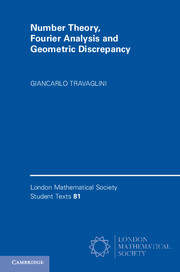Description
Number Theory, Fourier Analysis and Geometric Discrepancy
London Mathematical Society Student Texts Series
Classical number theory is developed from scratch leading to geometric discrepancy theory, with Fourier analysis introduced along the way.
Language: English
Number Theory, Fourier Analysis and Geometric Discrepancy
Publication date: 06-2014
Support: Print on demand
Publication date: 06-2014
Support: Print on demand
Number Theory, Fourier Analysis and Geometric Discrepancy
Publication date: 06-2014
252 p. · 15.2x22.9 cm · Hardback
Publication date: 06-2014
252 p. · 15.2x22.9 cm · Hardback
Description
/li>Contents
/li>Biography
/li>
The study of geometric discrepancy, which provides a framework for quantifying the quality of a distribution of a finite set of points, has experienced significant growth in recent decades. This book provides a self-contained course in number theory, Fourier analysis and geometric discrepancy theory, and the relations between them, at the advanced undergraduate or beginning graduate level. It starts as a traditional course in elementary number theory, and introduces the reader to subsequent material on uniform distribution of infinite sequences, and discrepancy of finite sequences. Both modern and classical aspects of the theory are discussed, such as Weyl's criterion, Benford's law, the Koksma?Hlawka inequality, lattice point problems, and irregularities of distribution for convex bodies. Fourier analysis also features prominently, for which the theory is developed in parallel, including topics such as convergence of Fourier series, one-sided trigonometric approximation, the Poisson summation formula, exponential sums, decay of Fourier transforms, and Bessel functions.
Part I. Elementary Number Theory: 1. Prelude; 2. Arithmetic functions and integer points; 3. Congruences; 4. Quadratic reciprocity and Fourier series; 5. Sums of squares; Part II. Fourier Analysis and Geometric Discrepancy: 6. Uniform distribution and completeness of the trigonometric system; 7. Discrepancy and trigonometric approximation; 8. Integer points and Poisson summation formula; 9. Integer points and exponential sums; 10. Geometric discrepancy and decay of Fourier transforms; 11. Discrepancy in high dimension and Bessel functions; References; Index.
Giancarlo Travaglini is Professor of Mathematics at the University of Milano-Bicocca. He is the author of numerous research papers and several books in the areas of abstract harmonic analysis, Fourier analysis and discrepancy theory. He is a member of the Unione Matematica Italiana and the American Mathematical Society. His current mathematical interests include Fourier analysis, discrepancy theory, radon transforms and didactics of mathematics.
© 2024 LAVOISIER S.A.S.
These books may interest you

A Panorama of Discrepancy Theory 52.74 €

An Introduction to Fourier Analysis 117.69 €


